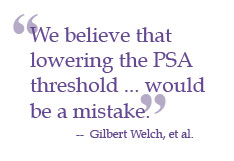|
|
For Release: August 10, 2005
Contact: Deborah Kimbell (603) 653-1913
Few Benefits, Many Costs Associated With Changing Definition of "Abnormal" PSA Level

Drs. Steven Woloshin, Gilbert Welch, and Lisa Schwartz, from left
Photo by Jon Fox
Hanover, NH and White River Junction, VT—Lowering the current prostate-specific antigen (PSA) threshold for recommending a prostate biopsy may subject millions of men to unnecessary, potentially harmful medical procedures with no evidence that it will improve prostate cancer mortality rates, according to a new study by researchers from Dartmouth Medical School (DMS) and the VA Outcomes Group. The study appears in the August 3 issue of the Journal of the National Cancer Institute.
Currently, doctors recommend that men with an "abnormal" PSA level—a level exceeding 4.0 ng/mL—receive a prostate biopsy to test for prostate cancer. However, some men diagnosed with prostate cancer have a PSA level lower than this threshold, prompting some in the medical field to suggest lowering the cutoff to 2.5 ng/mL to possibly detect more cancer cases.
To examine the implications of this suggestion, H. Gilbert Welch, MD, MPH, of the Center for the Evaluative Clinical Sciences at DMS and the Department of Veterans Affairs Medical Center in White River Junction, Vt., and colleagues examined data from the 2001-2002 National Health and Nutrition Examination Survey for 1,308 men of 40 years of age or older with no prior history of prostate cancer, and National Cancer Institute data on the risk of prostate cancer death. Using this information, they calculated the effects of lowering the PSA cutoff to 2.5 ng/mL on men screened by a PSA test.
Welch and colleagues Lisa M. Schwartz and Steven Woloshin found that if all US men aged 40-69 (those most likely to be screened) were tested using PSA with a 4.0 ng/mL threshold, about 1.5 million of them would have a PSA level abnormally high enough to justify a biopsy. Lowering the threshold to 2.5 ng/mL would call for an additional 1.8 million men to receive biopsies. This group of "abnormal" men would comprise 10.7% of all US men between the ages of 50 and 59, and 17% of men between the ages of 60 and 69.

To put things into perspective the authors point out that in the next 10 years, relatively few men are expected to die from prostate cancer—0.3% of men aged 50-59, and 0.9% of men aged 60-69.
The authors note that no studies to date have focused on the actual effectiveness of PSA screening in terms of cancer mortality and survival rates, so setting a PSA threshold to maximize the number of potential cases detected may not translate into saving lives. "The problem is that although it is easy to diagnose more prostate cancer, it is not easy to know who has clinically important disease," they write.
If the PSA threshold level is to be changed, the authors argue that it should be set higher, not lower. "Raising the threshold would enhance the net effect of PSA screening by identifying the people at highest risk of clinically significant disease and thereby limiting the number of healthy people harmed," they conclude. "We believe that lowering the PSA threshold ... would be a mistake."
Welch is the author of "Should I Be Tested for Cancer? Maybe Not and Here's Why," published in 2004 by the University Of California Press. Together with Schwartz and Woloshin, he has published numerous studies looking at the efficacy of screening. All three are faculty members at Dartmouth Medical School, members of the Center for the Evaluative Clinical Sciences at DMS, and primary members of the VA Outcomes Group, working from the Veterans Affairs Medical Center in White River Junction, VT.
-DMS-